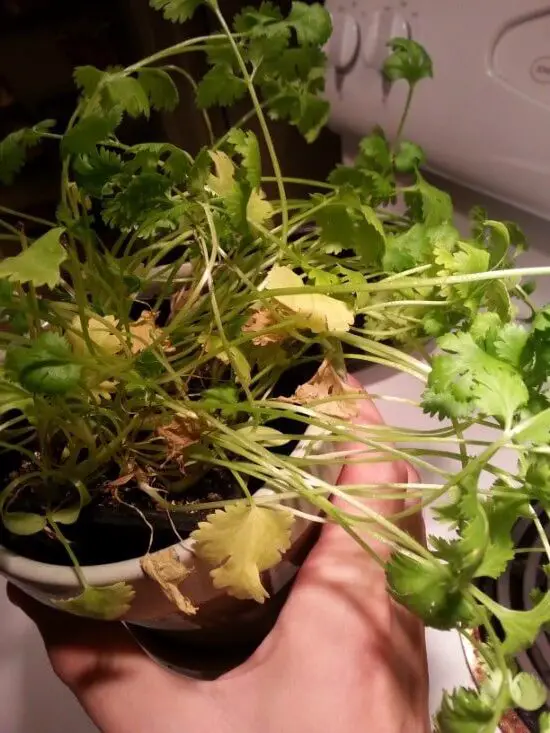Is your cilantro mysteriously turning yellow? Don’t worry, we’ve got you covered! It’s frustrating to see your once vibrant and lush herb garden suddenly losing its vibrancy. But fear not, we have some insights that may shed light on the issue.
In this article, we will explore the reasons why your cilantro might be turning yellow and provide you with practical solutions to get it back to its green glory. So, if you’ve been wondering, “Why is my cilantro turning yellow?”, keep reading to find out the possible causes and how to address them.
Why Is My Cilantro Turning Yellow? Find Out Now!
Cilantro, also known as coriander, is a popular herb used in various cuisines around the world. Its vibrant green leaves can add freshness and flavor to any dish. However, it can be concerning when your cilantro starts turning yellow.
The change in color could indicate an underlying issue that needs attention. In this article, we will explore the possible reasons why your cilantro might be turning yellow and how to address the problem effectively.
1. Environmental Factors
Cilantro plants are sensitive to their environment, and several factors can contribute to the yellowing of their leaves. Understanding these environmental factors can help you identify and address the issue promptly.
Here are some common environmental factors that may cause cilantro to turn yellow:
a) Lack of Sunlight
Cilantro thrives in full sunlight. If your cilantro is not receiving enough sunlight, its leaves may start turning yellow. Ensure that your cilantro receives at least six hours of direct sunlight each day.
If you are growing it indoors, place it near a sunny window or use a grow light to provide sufficient light.
b) Excessive Heat
High temperatures can cause cilantro leaves to yellow. If you live in a hot climate, provide some shade to protect your cilantro plants during the hottest part of the day.
Additionally, consider watering your cilantro more frequently to prevent the soil from drying out too quickly in the heat.
c) Overwatering or Underwatering
Improper watering practices can also lead to yellowing of cilantro leaves. Overwatering can cause root rot and yellowing, while underwatering can make the leaves dry out and turn yellow.
Find the right balance by watering your cilantro when the top inch of soil feels dry. Ensure proper drainage to prevent waterlogged roots.
Read More: About Do Pothos Need Drainage?
d) Soil Quality
The quality of the soil plays a significant role in the health of cilantro plants. If the soil lacks essential nutrients or has poor drainage, it can lead to yellowing leaves.
Use well-draining soil rich in organic matter and consider adding compost or fertilizer to provide the necessary nutrients for healthy growth.
2. Pests and Diseases
Cilantro plants can also be susceptible to pests and diseases, which can cause yellowing of the leaves. Identifying and treating these issues promptly is crucial to prevent further damage.
Here are some common pests and diseases that can affect cilantro:
a) Aphids
Aphids are small insects that feed on the sap of cilantro plants, causing the leaves to curl and turn yellow. You can control aphids by using insecticidal soap or a strong stream of water to wash them off the leaves. Beneficial insects like ladybugs can also help control aphid populations.
b) Fusarium Wilt
Fusarium wilt is a fungal disease that can cause yellowing and wilting of cilantro plants. It is important to prevent the disease by planting cilantro in well-draining soil and avoiding overwatering. If your cilantro is affected, remove and destroy the infected plants to prevent the spread of the disease.
c) Root Knot Nematodes
Root knot nematodes are microscopic worm-like organisms that can infest the roots of cilantro plants, causing stunted growth and yellowing leaves. Unfortunately, there is no cure for root knot nematodes once the plants are infected. To prevent infestation, rotate crops and avoid planting cilantro in soil known to be infested.
3. Nutrient Deficiencies
Cilantro plants require a balanced supply of nutrients to thrive. A deficiency of essential nutrients can lead to yellowing of the leaves. Here are some common nutrient deficiencies that can affect cilantro:
a) Nitrogen Deficiency
Nitrogen is a vital nutrient for leafy green plants like cilantro. A lack of nitrogen can cause the leaves to turn yellow. To address nitrogen deficiency, consider using a nitrogen-rich fertilizer or adding organic matter such as compost or manure to the soil.
b) Iron Deficiency
Iron deficiency can manifest as yellowing leaves with green veins, a condition known as chlorosis. If you suspect iron deficiency, you can apply iron chelates or iron sulfate to the soil to correct the issue. Adjusting the soil pH to slightly acidic levels can also enhance iron availability to the plants.
c) Other Nutrient Deficiencies
Yellowing leaves can indicate deficiencies in other essential nutrients such as potassium, phosphorus, or magnesium. Conduct a soil test to identify any nutrient deficiencies and amend the soil accordingly using organic fertilizers or targeted mineral supplements.
By understanding and addressing the environmental factors, pests and diseases, and nutrient deficiencies that can cause cilantro to turn yellow, you can ensure healthy and vibrant plants. Regularly monitor your cilantro plants for any signs of yellowing, and take appropriate action promptly to maintain their overall health and productivity.
Remember, growing cilantro successfully requires attentiveness and proper care, but the reward of fresh and flavorful herbs makes it all worthwhile.
Frequently Asked Questions (FAQs)
Yellowing of cilantro leaves can occur due to various reasons:
1. Lack of sunlight: Cilantro requires at least 6 hours of direct sunlight per day. If it is not getting enough sunlight, it can cause yellowing of the leaves.
2. Overwatering: Cilantro prefers well-draining soil. Overwatering can lead to root rot and yellowing of the leaves.
3. Nutrient deficiencies: Yellowing of cilantro can be a sign of nutrient deficiencies, such as nitrogen or iron.
4. Pests or diseases: Infestation of pests like aphids or diseases like fungal infections can cause yellowing of cilantro leaves.
5. Environmental stress: Extreme temperatures, high humidity, or sudden weather changes can stress cilantro plants, leading to yellowing of leaves.
To prevent cilantro from turning yellow, consider the following tips:
1. Ensure proper sunlight: Place cilantro in a spot where it receives at least 6 hours of direct sunlight daily.
2. Adequate watering: Water cilantro when the top 1-2 inches of soil feels dry. Avoid overwatering, as it can lead to root rot.
3. Fertilize regularly: Use a balanced fertilizer to provide essential nutrients to your cilantro plants.
4. Monitor for pests and diseases: Regularly inspect your cilantro plants for pests or signs of diseases. Treat them promptly if detected.
5. Provide proper ventilation: Ensure good air circulation around your cilantro plants to prevent humidity-related issues.
Yes, yellowing cilantro is generally safe to eat. However, the flavor and quality may be compromised. It is best to harvest cilantro leaves before they turn completely yellow.
Yes, overfertilization can cause yellowing of cilantro leaves. Excessive amounts of fertilizers, especially those high in nitrogen, can lead to nutrient imbalances and yellowing of the foliage.
To revive yellow cilantro:
1. Adjust sunlight: Ensure your cilantro gets adequate sunlight. Move it to a sunnier location if necessary.
2. Adjust watering: Water cilantro appropriately, allowing the soil to dry slightly between waterings.
3. Check for pests and diseases: Inspect your cilantro for any signs of pests or diseases. Treat them accordingly.
4. Improve soil conditions: If nutrient deficiencies are suspected, apply appropriate fertilizers or compost to enrich the soil.
While yellow cilantro can still be used, it is best to harvest the healthy green leaves for consumption. Yellowing leaves may have a compromised flavor and texture.
Common pests that can cause cilantro to turn yellow include:
1. Aphids: These tiny insects feed on the sap of cilantro plants, causing stunted growth and yellowing of leaves.
2. Spider mites: These tiny arachnids suck the sap from cilantro leaves, leading to discoloration and yellowing.
3. Whiteflies: These small, white insects can infest cilantro plants, causing yellowing, wilting, and a sticky residue on leaves.
To protect your cilantro from pests:
1. Regularly inspect your plants for signs of pests.
2. Use organic or chemical insecticides specific to the pests affecting your cilantro.
3. Introduce beneficial insects like ladybugs or lacewings, which feed on pest insects.
4. Avoid overcrowding plants, as it can promote pest infestations.
Read More: About Gardening In An Apartment Without A Balcony
Final Thoughts
Cilantro, a popular herb known for its strong aroma and fresh flavor, can sometimes perplex gardeners when it starts turning yellow. Several factors can contribute to this issue. First, overwatering can lead to root rot and yellowing leaves. Second, inadequate sunlight can hinder the plant’s growth, causing it to turn yellow.
Additionally, nutrient deficiencies, such as lack of nitrogen or iron, can impact cilantro’s health. Pests and diseases, such as aphids or fungal infections, may also discolor the plant. To address this problem, ensure proper watering, provide ample sunlight, and maintain a well-balanced nutrient supply. Regular monitoring and early intervention can help resolve why your cilantro is turning yellow.
Auto Amazon Links: No products found.
Perfect Plants Christmas Tree Saver 8oz. | Easy Use Xmas Tree Preserver Food | Have Healthy Green Christmas Trees All Holiday Season
$9.97 (as of December 12, 2025 05:04 GMT +00:00 - More info- Product prices and availability are accurate as of the date/time indicated and are subject to change. Any price and availability information displayed on [relevant Amazon Site(s), as applicable] at the time of purchase will apply to the purchase of this product.
Rocky Mountain Goods Christmas Tree Food - 8 oz Tree Preservative - Reduce Needle Drop - Greener Scent - Fir, Pine, Spruce Trees - Extend Tree Life
$9.95 (as of December 12, 2025 05:04 GMT +00:00 - More info- Product prices and availability are accurate as of the date/time indicated and are subject to change. Any price and availability information displayed on [relevant Amazon Site(s), as applicable] at the time of purchase will apply to the purchase of this product.
VICAMB 39.3 Inch Christmas Tree Watering Funnel,Christmas Tree Watering System Device,Long Tree Watering Funnel Spout for Indoor Outdoor Xmas Tree
$16.99 (as of December 12, 2025 05:04 GMT +00:00 - More info- Product prices and availability are accurate as of the date/time indicated and are subject to change. Any price and availability information displayed on [relevant Amazon Site(s), as applicable] at the time of purchase will apply to the purchase of this product.
FirEver Pure Christmas Tree Food | Preserver Additive & Season Extender for Live Xmas Trees | Keep It Green, Reduce Needle-Drop | Miracle Freshness (8 oz)
$14.99 (as of December 12, 2025 05:04 GMT +00:00 - More info- Product prices and availability are accurate as of the date/time indicated and are subject to change. Any price and availability information displayed on [relevant Amazon Site(s), as applicable] at the time of purchase will apply to the purchase of this product.
EZMeetU Christmas Tree Watering Funnel, 47 Inch Flower Shape Adjustable 6 Section Design, Christmas Tree Watering System, Christmas Tree Waterer, Long Funnel Wide Opening Reusable, Plant Watering Tool
$16.99 (as of December 12, 2025 05:04 GMT +00:00 - More info- Product prices and availability are accurate as of the date/time indicated and are subject to change. Any price and availability information displayed on [relevant Amazon Site(s), as applicable] at the time of purchase will apply to the purchase of this product.
Snow Joe Premium Enviro Blend Ice Melt, Green-Coated Deicer Crystals, 50 lb - Safer Melter for Vegetation, Concrete & Metals w/ Anti-Corrosion Calcium Magnesium Acetate
$32.97 (as of December 11, 2025 19:12 GMT +00:00 - More info- Product prices and availability are accurate as of the date/time indicated and are subject to change. Any price and availability information displayed on [relevant Amazon Site(s), as applicable] at the time of purchase will apply to the purchase of this product.
Muddy Mat® Shown on TV Super Absorbent Microfiber Dog Door Mat for Muddy Paws, Non-Slip Washable Pet Rug, Quick Dry Chenille Entryway Carpet, Machine Washable Indoor Outdoor mat, Grey 30"x19"
$24.95 (as of December 11, 2025 19:12 GMT +00:00 - More info- Product prices and availability are accurate as of the date/time indicated and are subject to change. Any price and availability information displayed on [relevant Amazon Site(s), as applicable] at the time of purchase will apply to the purchase of this product.
ivtivfu Rolling Grill Basket, Removable Wooden Handle, 304 Stainless Steel, Nesting BBQ Tools, Smoker Grilling Accessories for Vegetable, Outdoor Cooking Camping, Birthday Gifts for Men Dad Husband
$25.99 (as of December 11, 2025 19:12 GMT +00:00 - More info- Product prices and availability are accurate as of the date/time indicated and are subject to change. Any price and availability information displayed on [relevant Amazon Site(s), as applicable] at the time of purchase will apply to the purchase of this product.
XXXFLOWER Plant Terrarium with Wooden Stand, Air Planter Bulb Glass Vase Metal Swivel Holder Retro Tabletop for Hydroponics Home Garden Office Decoration - 3 Bulb Vase
$18.98 (as of December 11, 2025 19:12 GMT +00:00 - More info- Product prices and availability are accurate as of the date/time indicated and are subject to change. Any price and availability information displayed on [relevant Amazon Site(s), as applicable] at the time of purchase will apply to the purchase of this product.
Zevo Flying Insect Trap Official Refill Cartridges - Fits Both Zevo Trap & MAX Indoor Fly Trap - Authentic Trap+Lock Technology to Catch Gnats, House & Fruit Flys (4 Official Refill Cartridges)
$14.97 (as of December 11, 2025 19:12 GMT +00:00 - More info- Product prices and availability are accurate as of the date/time indicated and are subject to change. Any price and availability information displayed on [relevant Amazon Site(s), as applicable] at the time of purchase will apply to the purchase of this product.











